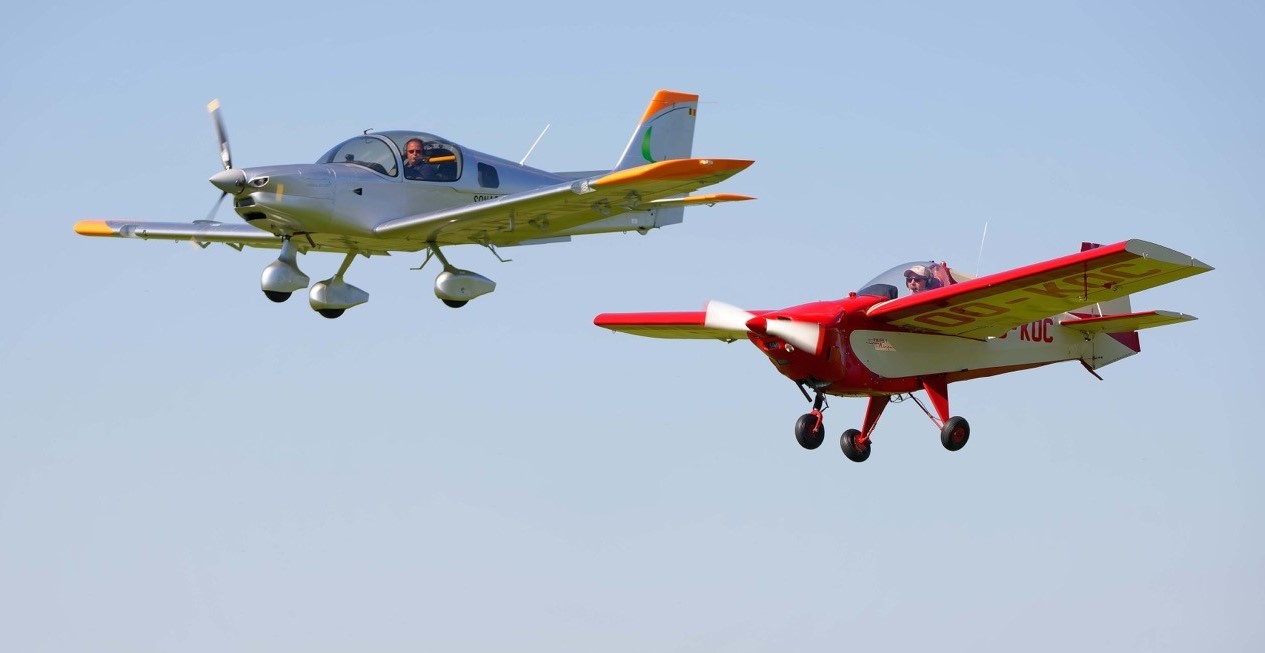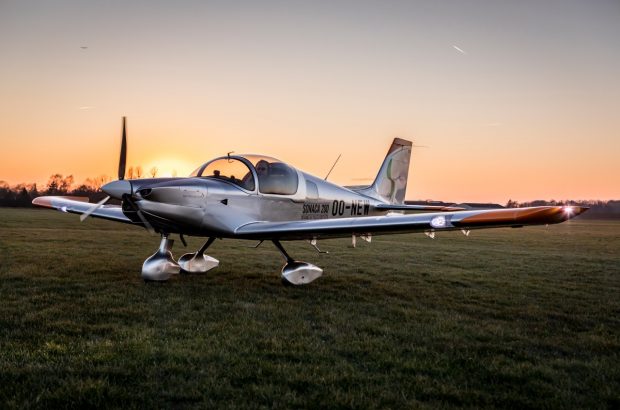- Daily & Weekly newsletters
- Buy & download The Bulletin
- Comment on our articles
Wings over Wallonia: The Sonaca 200 aircraft represents historic moment in Belgian aviation
Taking off from Temploux Aerodrome in Namur, the Sonaca 200 training aircraft, is a new single-engine, two-seater plane destined for the flight school and leisure market. It is the first time in decades that a Belgian aeroplane has been launched.
The awarding of the EASA airworthiness certificate means the aircraft is fit to fly in Europe and the rest of the world – a major achievement after the end of a three-year procedure. With the first aircraft already delivered in October and a further eight to be completed by the end of the year, the Sonaca 200 order book is surpassing expectations. “We were hoping to have orders for ten aircraft and we are already at over forty, which is massive,” says Pierre Van Wetter, chief commercial director and co-founder of Sonaca Aircraft, a subsidiary of Sonaca Group.
Proudly displayed on the fuselage of the silver aluminium aircraft is the tagline ‘Designed by pilots for pilots’. Van Wetter adds: “It’s an extraordinary aircraft, lively and fun yet very precise.” And crucially for a training plane, it has the lightness and stability that are key in enabling pilots to move on to heavier aircraft types.
“It’s important to have an aeroplane that is not too buffeted by turbulence and wind. It needs to be robust, which is not always the case with our competitors,” says Van Wetter. “In developing it, we focused on the training aspect, preferring an aircraft with a not-too high flight speed that forgives errors when taking off and landing or experiencing loss of speed.” Two versions are on sale (Trainer and Trainer Pro), with two more in the pipeline: the "Upset Prevention and Recovery Training" (UPRT) and the "IFR - Instrument Flight Rules" versions.

With an ambition to deliver up to 80 aircraft each year, Sonaca Aircraft is counting on its after-sales technical service and Made in Belgium label to fuel its reputation. It benefits from being a subsidiary of the Sonaca Group, a renowned Belgian aerospace company based at Gosselies, near Charleroi. Largely owned by the Wallonia Regional Investment Company (SRIW), it has a 90% stake in Sonaca Aircraft. “Sonaca appreciates that even if we are not a major business in terms of turnover, it continues the aeronautical spirit at the heart of the company because it gives the group an excellent image and is an example of internal innovation and a complete aircraft,” says Van Wetter.
It was in 2014 that a couple of Sonaca engineers – all with a passion for flying – had the idea of developing a complete aeroplane. With the group keen on diversifying while remaining in the aeronautical domain, it gave the project the green light on condition that the budding entrepreneurs sought specialist advice from business coaches. “This enabled us to advance very quickly and by 2015 we had a clear idea of the type of aircraft, certification and market to target,” Van Wetter says. “But the coaches said it would be crazy to invent a new aircraft, so with feedback from flying schools across Europe, we found an interesting aircraft in South Africa, the Sling 2.”
The ensuing collaboration allowed Sonaca Aircraft to heavily modify it to develop a type that would meet European certification standards and the criteria necessary for training pilots. Since its launch, the company has been targeting international sales. “Having EU certification enables us to enter the major markets," says Van Wetter. “With after-sales service, it’s easier to sort out a problem when it’s on your doorstep rather than further afield. Since conception, we’ve had maintenance costs in mind because it’s one of the major expenses when operating an aircraft,” he adds.
The structural parts of the Sonaca 200 are made in Romania and transported overnight by road for final assembly at Temploux. “But all the know-how remains here,” points out Van Wetter. Today the company has almost 30 employees, the majority of them aeronautical mechanics from the Namur, Liège and Charleroi area. Once in full production, Van Wetter predicts a workforce of around 50.
While the company is currently operating from a temporary hangar, a new purpose-built building is being constructed and will be completed by the beginning of 2019. Conveniently situated next to the aerodrome’s new hard runway, it has space for engine testing and easy access for test flights; the aircraft has to complete two hours of flight time before it is ready for delivery.
Namur’s location offered numerous advantages, says Van Wetter. “Clients can arrive from Brussels National or Charleroi airport and hire a car to drive to Temploux, or fly in directly. Being in the centre of Belgium, between France and Germany, is strategically important.” The aerodrome at Temploux, which specializes in light aviation and leisure activities, has been undergoing a modernisation programme since coming under new ownership in 2017. In addition to the tarmac replacement of the grass airstrip, the infrastructure is being updated and the aerodrome is diversifying its activities, which include the agreement with Sonaca Aircraft.
Even if the order book is looking healthy, the company has additional aircraft types in its sights. “We are developing and testing the Sonaca 200 structure to have authorisation for basic aerobatics as well as an Instrument Flight Rating version,” says Van Wetter. “The former is in high demand by the army as well as flight instructors because they realise that certain airline company accidents and incidents could be prevented if there was a return to basic aerobatic skills, useful for recuperating an aircraft in some situations,” he explains.
The company is equally aware of the symbolism of making the first new Belgian aircraft since the 1970s. The Sonaca Group began life as Avions Fairey, a subsidiary of British manufacturer Fairey Aviation, which was set up in 1931 by Belgian aviation pioneer Ernest-Oscar Tips and commissioned to make aircraft for the Belgian army. Tips also designed light aircraft, known as the Tipsy family, which were widely successful at home and abroad.

A restored Tipsy Trainer is on display at the Royal Army Museum in Brussels, on loan from the designer’s two grandsons. The pair take a keen interest in Sonaca Aircraft’s activities. “They may suspend the Tipsy from the roof of our new showroom,” says Van Wetter, who earlier this year enjoyed piloting the Sonaca 200 in a formation flight with another Fairey legend, the single-seater Tipsy Nipper, over the skies of Namur. “It would be a nod to the history of the company. If we created a complete aircraft, it surely arose from the company’s continual passion for flying.”
IN FIGURES
Engine BRP-Rotax 914 F – 115 hp
Seats 2
Dimensions Wing span 9.15m, length 7m
Weight & load Weight empty 460kg, max take-off weight 750kg, fuel capacity 150l
Performance Max cruise speed 115knots, rate of climb 750 ft/min
Fuel consumption 18 l/hr
Price From €177,500
This article was first published in the Wab magazine, autumn 2018



















